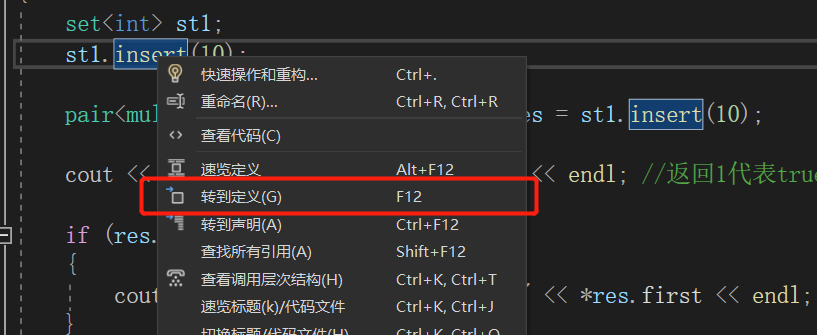215讲 list容器、set容器、仿函数
list基本概念 (链表)
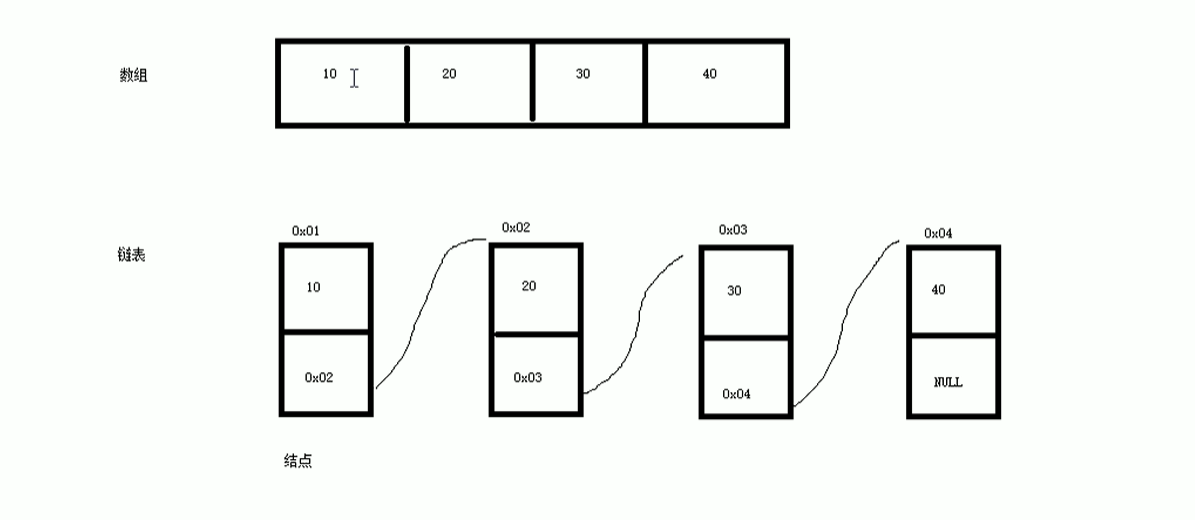
优点:
可以对任意位置进行快速插入或删除
缺点:
1.容器遍历速度没有数组快
2.占用空间比数组大
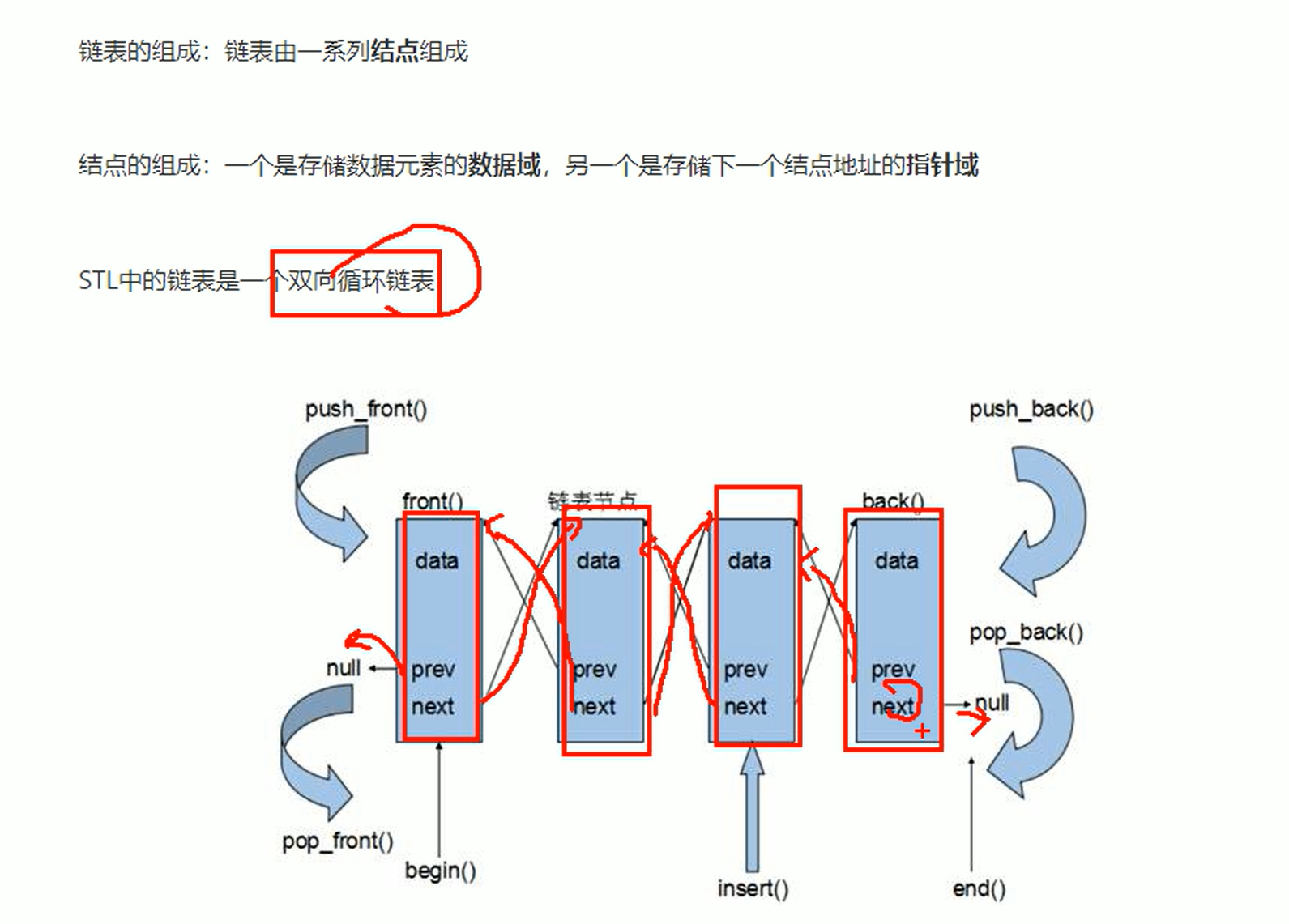
由于链表存储方式不是连续的内存空间,因此链表list 中的迭代器只支持前移和后移,属于双向迭代器
list 的优点:
- 采用动态存储分配,不会造成内存浪费和溢出
- 链表执行插入和删除操作十分方便,修改指针即可,不需要移动大量元素
list 的缺点:
- 链表灵活,但是空间(指针域)和 时间(遍历)额外耗费较大
list 有一个重要的性质,插入操作和删除操作都不会造成原有的list 迭代器的失效,这在vector是不成立的
总结:STL中List 和 vector是两个最常被使用的容器,各有优缺点
list构造函数
功能:
- 创建list 容器
函数原型:
list<T> lst;// list 采用模板类实现,对象的默认构造形式。list(beg,end);//构造函数将 [ beg , end) 区间中的元素拷贝给本身。list(n,elem);//构造函数将 n 个 elem 拷贝给本身。list(const list &lst);//拷贝构造函数。
void showList(list<int> lst) {
for (list<int>::iterator it = lst.begin();it != lst.end();it++)
{
cout << *it << " ";
}
cout << endl;
}
//list 的构造函数的使用
void test() {
//1. 默认构造函数,使用模板类实现
list<Person> lst1;
vector<int> vec;
for (int i = 0; i < 10; i++)
{
vec.push_back(i);
}
for (vector<int>::iterator it = vec.begin();it != vec.end();it++)
{
cout << *it << endl;
}
cout << "以下是list类型" << endl;
//2.
list<int> list2(vec.begin(), vec.end());
showList(list2);
cout << "3333333333333333333333333" << endl;
//3.list(n,m);
list<int> list3(5, 10);
showList(list3);
//4.拷贝构造函数创建新的容器
list<int> list4(list3);
}总结:list构造方式和其它几个STL常用容器相似,熟练掌握即可
list 赋值和交换
功能描述:
- 给 list 容器进赋值,以及交换 list 容器
函数原型:
-
assign(beg,end);//将 [ beg, end) 区间中的数据拷贝赋值给本身。 -
assign(n,elem);//将n 个elem 拷贝赋值给本身 -
list& operator=(const list &list);//重载等号运算符 -
swap(lst);//将lst 与本身的元素互换
list 大小操作
功能:
- 对 list 容器的大小进行操作。
函数原型:
size();//返回容器中元素的个数empty();//判断容器是否为空resize(num);//重新指定容器的长度为num ,若容器变长,则以默认值填充新的位置。
//如果容器变短,则末尾超出容器长度的元素被删除。
resize(num,elem);//同上,但默认填充的为elem。
list 插入和删除
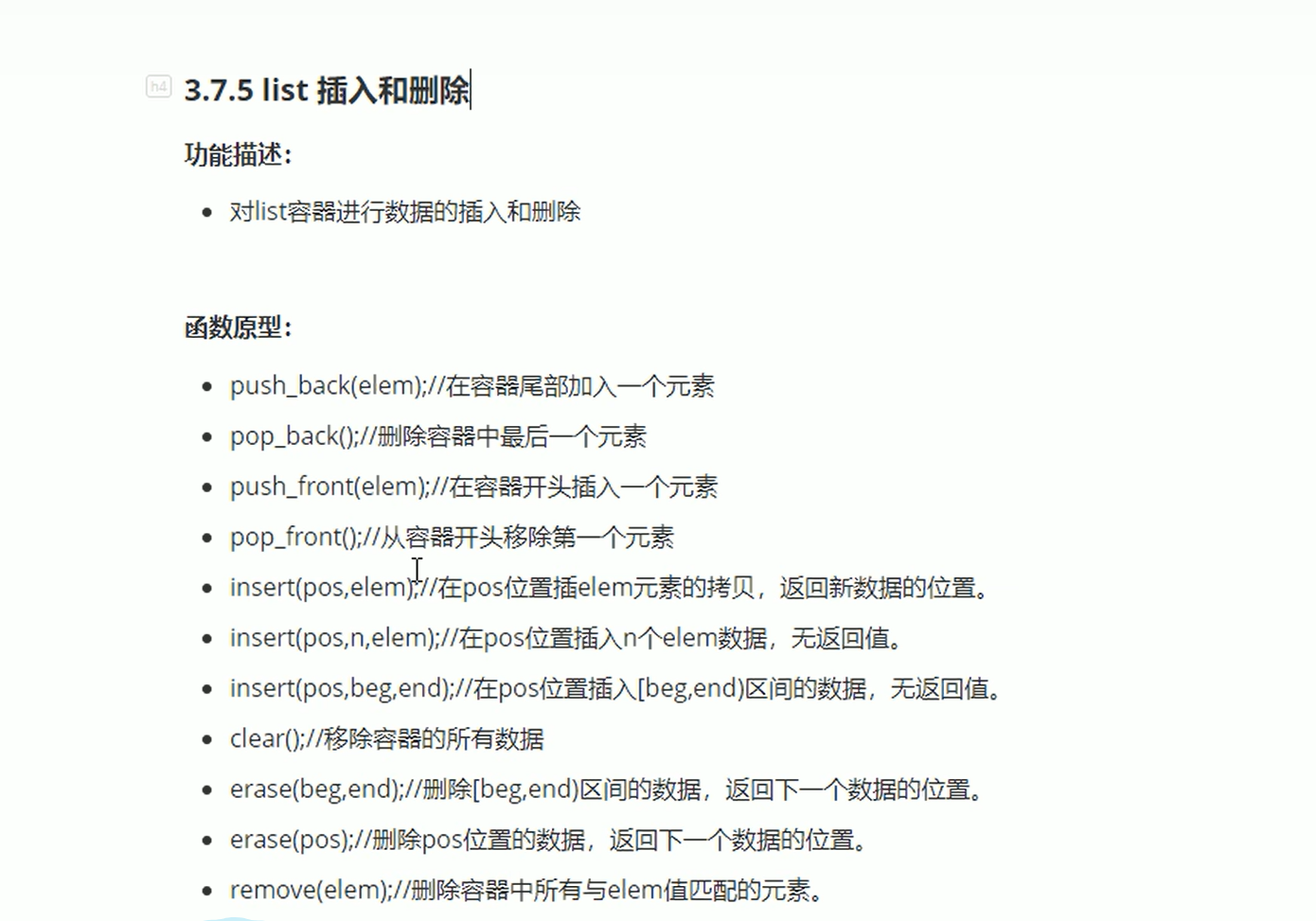
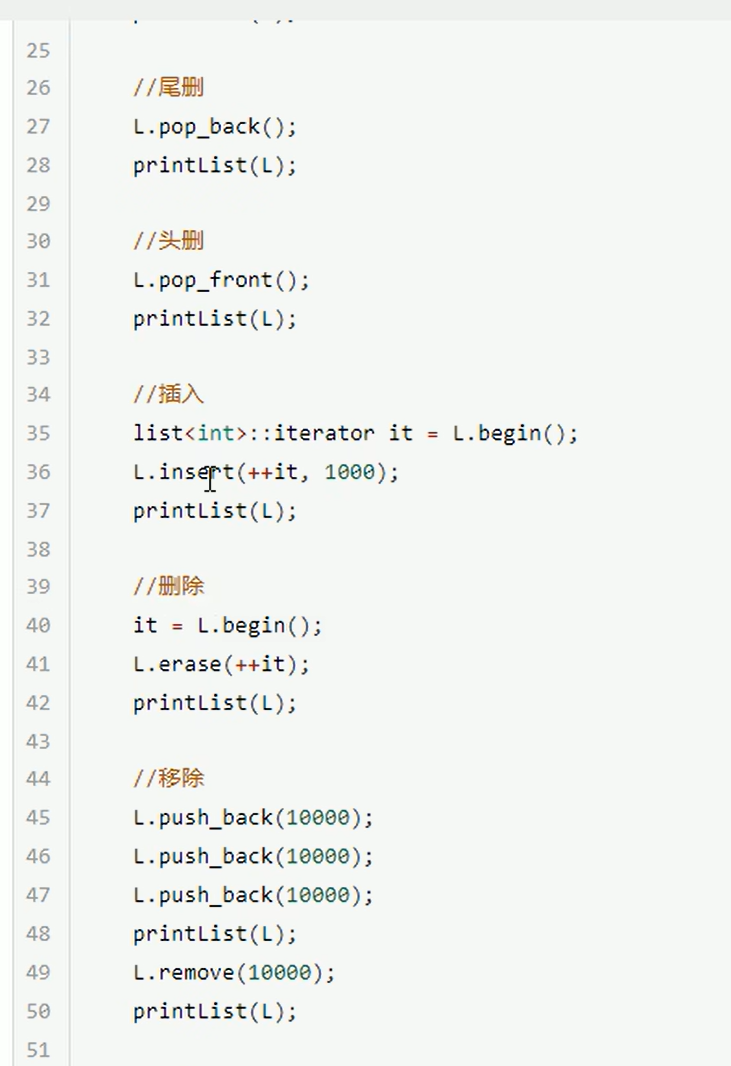
这里多了一个
移除 remove();它会把所有匹配的数移除掉
list数据存取
功能描述:
- 对list 容器中数据进行存取
函数原型:
front();//返回第一个元素back();//返回最后一个元素
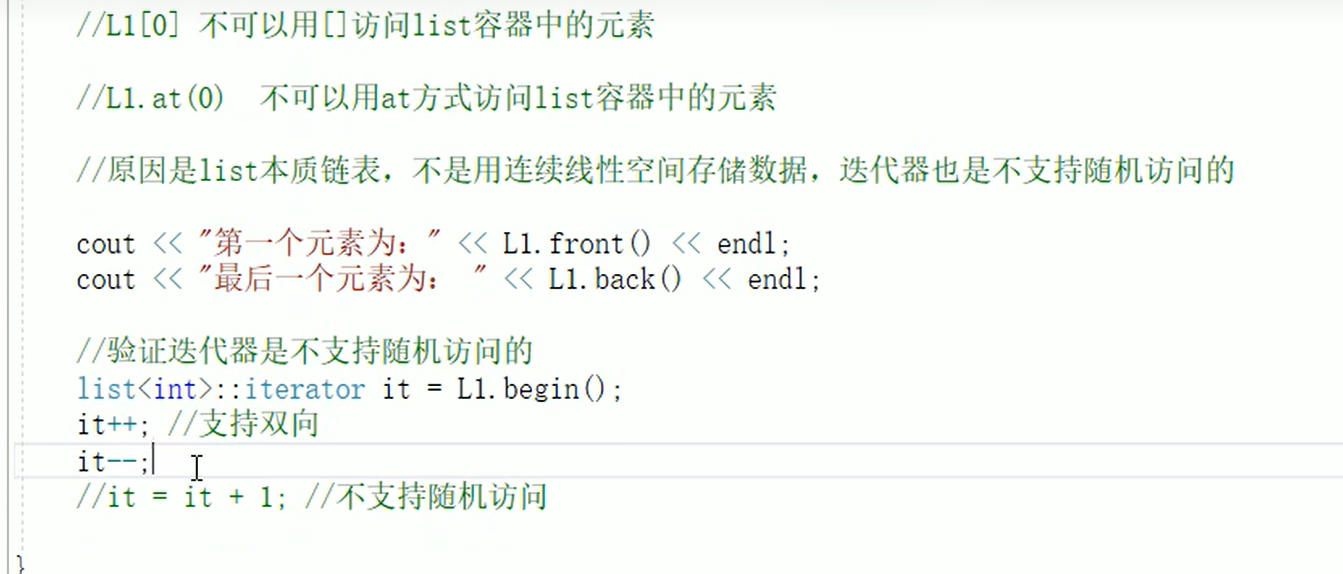
总结:
-
list 容器不可以通过 [ ] 或者 at( ); 方式访问数据
-
返回第一个元素 --- front( );
-
返回最后一个元素 --- back( );
list 反转和排序
功能描述:
- 将容器中的元素反转,以及将容器中的数据进行排序
函数原型:
reverse();//反转链表sort();//链表排序
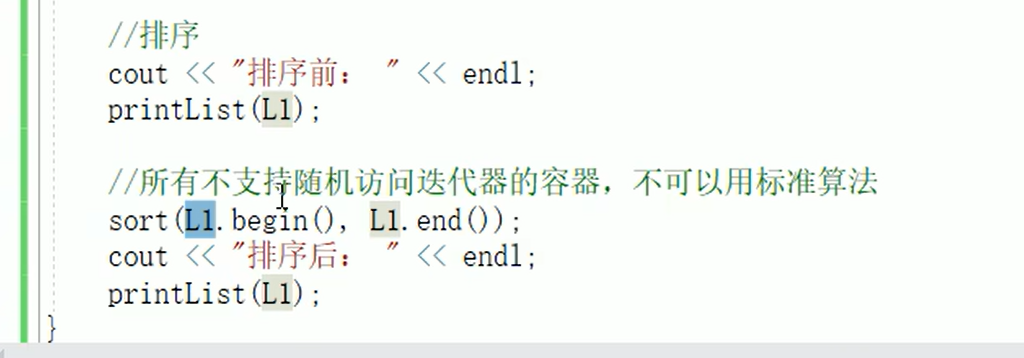
void test2() {
list<int> lst1;
lst1.push_back(1);
lst1.push_back(5);
lst1.push_back(2);
lst1.push_back(3);
lst1.push_back(9);
lst1.sort();
list<int>::iterator it1 = lst1.begin();
list<int>::iterator it2 = lst1.end();
//sort(it1,it2); //sort(lst1.begin(),lst1.end()); //这里编译器不会报错,但是运行会报错,
//所有不支持随机访问迭代器的容器,不可以使用<algorithm> 库中的标准算法
//不支持随机访问呢迭代器的容器,内部会提供对应的算法。!!!
showList(lst1);
cout << "反转后" << endl;
lst1.reverse();
showList(lst1);
}如果需要反向排序,则写一个比对函数,将结果提交给成员函数的 lst1.sort( myCompare(val1,val2));
bool myCompare(int val1, int val2)
{
return val1 > val2;
}
void test2(){
list<int> lst1;
lst1.push_back(1);
lst1.push_back(5);
lst1.push_back(2);
lst1.push_back(3);
lst1.push_back(9);
lst1.sort(myCompare);
}list容器案例
#include <iostream>
#include "string"
#include <list>
using namespace std;
class Person {
public:
Person(string name, int age, int height) {
m_name = name;
m_age = age;
m_height = height;
}
string m_name;
int m_age;
int m_height;
};
bool myCompare(Person &p1 , Person &p2) {
if (p1.m_age == p2.m_age) {
return p1.m_height < p2.m_height;
}
else
{
return p1.m_age > p2.m_age;
}
}
void printList(list<Person> &p)
{
for (list<Person>::iterator it = p.begin();it != p.end(); it ++)
{
cout << "\t姓名:" << it->m_name << "\t年龄:" << ( * it).m_age << "\t身高:" << ( * it).m_height << endl;
}
cout << endl;
}
void test() {
list<Person> lst1;
Person p1("张三" , 18 , 175);
Person p2("李四" , 23 , 186);
Person p3("王五" , 18 , 165);
Person p4("赵六" , 18 , 170);
Person p5("萨尼铁塔" , 43 , 190);
Person p6("模拟穷" , 29 , 195);
lst1.push_back(p1);
lst1.push_back(p2);
lst1.push_back(p3);
lst1.push_back(p4);
lst1.push_back(p5);
lst1.push_back(p6);
printList(lst1);
cout << "排序后的打印如下:" << endl;
lst1.sort(myCompare);
printList(lst1);
}
void main() {
test();
}
set 容器
简介:
- 所有元素都会在插入时自动被排序
本质:
- set/multiset 属于 关联式容器 , 底层结构是用 二叉树 实现。
set 和 multiset 区别:
- set 不允许容器中有重复的元素
- multiset 允许容器中有重复的元素
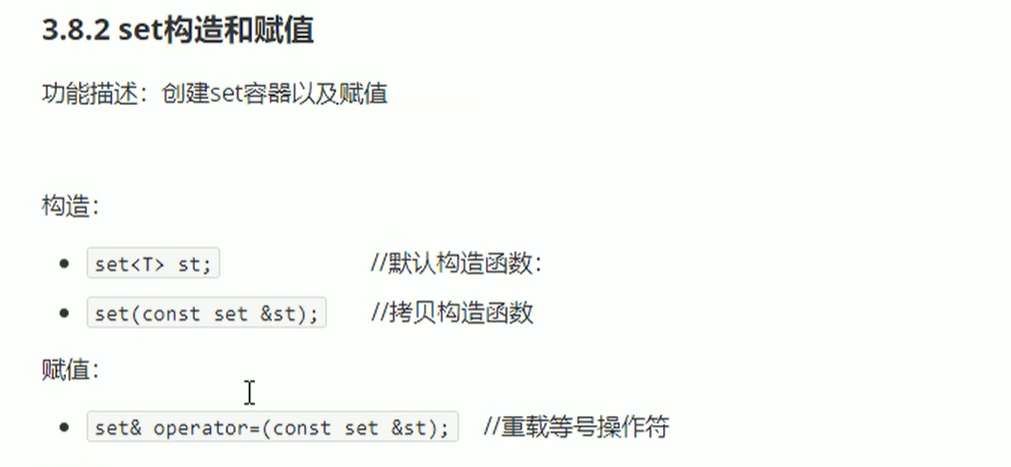
void printSet(set<int> set1) {
for (set<int>::iterator it = set1.begin(); it != set1.end(); it++)
{
cout << *it << " ";
}
cout << endl;
}
void test()
{
set<int> set1;
set1.insert(1);
set1.insert(3);
set1.insert(5);
set1.insert(4);
set1.insert(6);
printSet(set1);
}set容器大小和交换
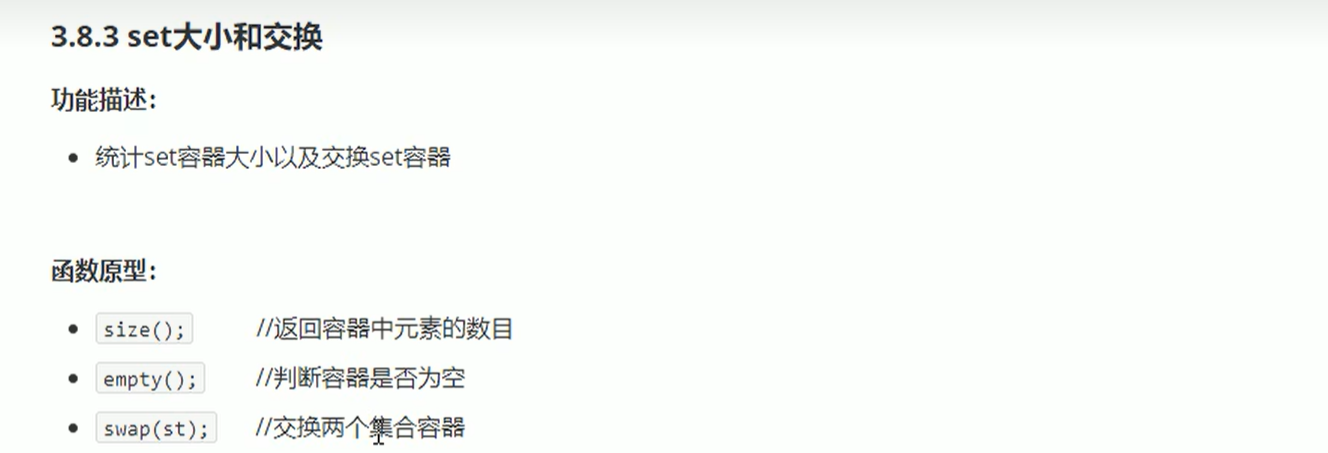
void test()
{
set<int> set1;
set1.insert(1);
set1.insert(3);
set1.insert(5);
set1.insert(4);
set1.insert(6);
//set容器的大小
cout << "容器的大小为: " << set1.size() << endl;
//判断容器是否为空
if (set1.empty()) {
cout << "容器为空" << endl;
}
else {
cout << "容器不为空" << endl;
}
cout << "===================================" << endl;
//容器交换
set<int> set2;
set2.swap(set1);
if (set1.empty()) {
cout << "set1 容器为空" << endl;
}
else {
cout << "set1容器不为空" << endl;
cout << "set1容器的大小为:" << set1.size() << endl;
}
if (set2.empty()) {
cout << "set2容器为空" << endl;
}
else {
cout << "set2容器不为空" << endl;
cout << "set2容器的大小为:" << set2.size() << endl;
}
printSet(set1);
}set容器的插入和删除
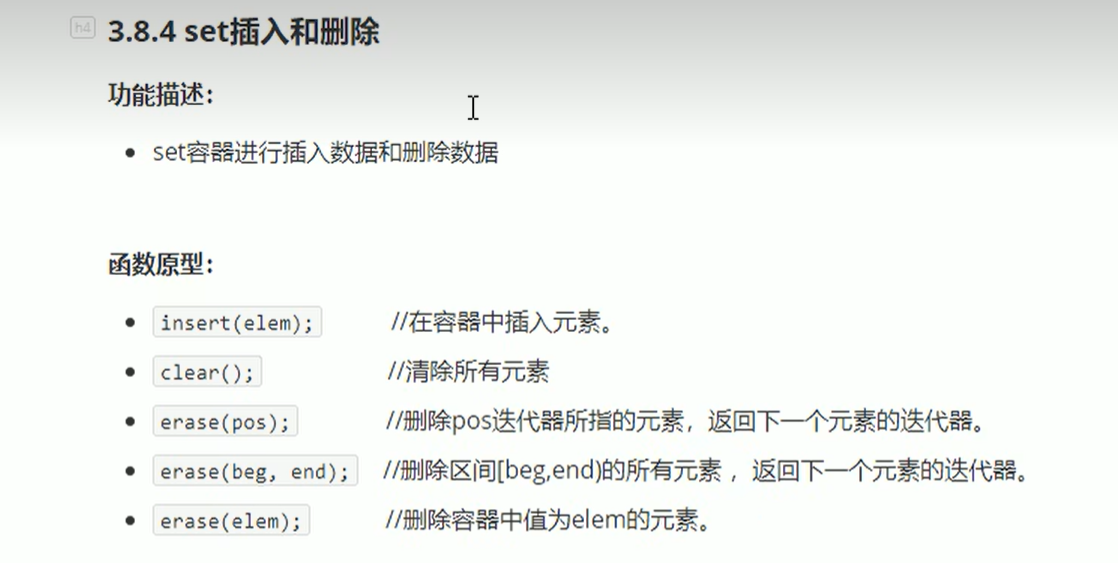
set容器查找和统计

#include <iostream>
#include <set>
using namespace std;
void printSet(const set<int>& st)
{
for (set<int>::const_iterator it = st.begin(); it != st.end() ; it++)
{
cout << *it << " ";
}
cout << endl;
}
void test1()
{
set<int> st1;
st1.insert(10);
st1.insert(30);
st1.insert(20);
st1.insert(40);
//set容器的查找
set<int>::iterator pos = st1.find(300);
if (pos != st1.end())
{
//容器的统计
cout << "找到该数据,且该数据的个数为:" << st1.count(30) << endl;
cout << &pos << endl;
}
else {
cout << "没有找到该数据" << endl;
//cout << "此时迭代器返回的: " << *pos << endl; 如果pos 为set.end(); 那么解指针之后会运行时报错
}
}
void main() {
test1();
}set 和 multiset 的区别

-
set中 insert方法返回的类型。

- multiset 容器的insert定义。
返回类型只有一个迭代器

因此,如果还是用set的模板来接收的话编译器会报错,因为这里的模板不能写 bool


void test()
{
set<int> st1;
st1.insert(10);
pair<set<int>::iterator ,bool> res = st1.insert(10);
cout << "res.second = " << res.second << endl; //返回1代表true ,插入成功。 返回0代表false 插入失败
if (res.second)
{
cout << "插入成功,且*res.first = " << *res.first << endl;
}
else {
cout << "插入失败,res.second = " << res.second << endl;
}
}
void main() {
test();
}
Summary
- 如果不允许插入重复数据,就选 set 容器;
- 如果需要插入重复数据,就选 multiset 容器;
pair对组创建
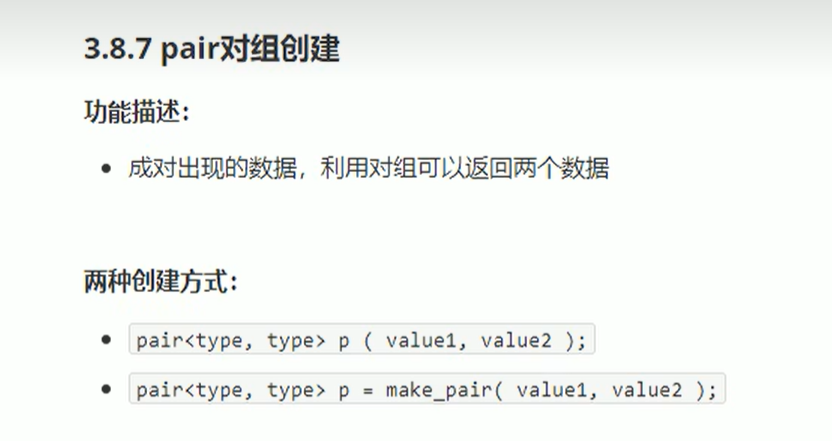
- 我发现对组一个好玩的地方,绿色方框中可以拆开来创建对组,但是红色方框会报错,不存在int ---> string的转换

void test()
{
pair<string, int > p1("Tom", 18);
cout << " 姓名:" << p1.first << " 年龄:" << p1.second << endl;
pair<string, int > p2 = make_pair("Jerry", 16);
cout << " 姓名:" << p2.first << " 年龄:" << p2.second << endl;
}
void main() {
test();
}set容器排序、仿函数
学习目标:
- set 容器默认排序规则为从小到大,掌握如何改变排序规则
主要技术点:
- 利用仿函数,可以改变排序规则
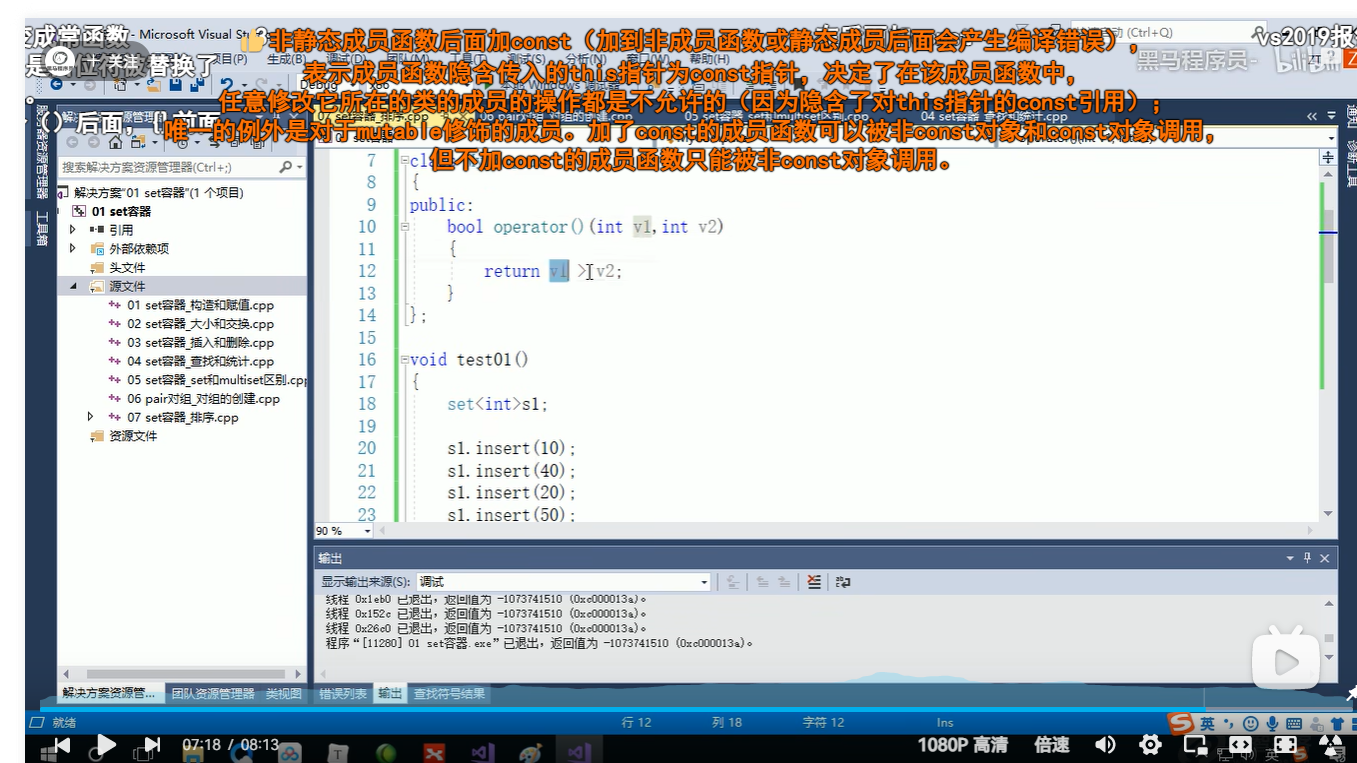
#include <iostream>
#include "string"
#include <set>
using namespace std;
class Person {
public:
Person(string name, int age) {
this->name = name;
this->age = age;
}
string name;
int age;
};
//仿函数部分,使用重载() 括号,来实现set 容器排序自定义数据类型。
class myCompare {
public:
// 注意 形参列表后面有一个 const , 这里的const 作用是让它变成···常函数···。常函数和常对象
bool operator()(const Person &p1,const Person &p2) const{
return p1.age > p2.age;
}
};
void printPerson(const set<Person,myCompare>& st) {
for (set<Person,myCompare>::const_iterator it = st.begin();it != st.end();it++)
{
cout << " 姓名: " << (*it).name << " 年龄: " << (*it).age;
cout << endl;
}
}
void test()
{
//set的第二个模板,通过仿函数来实现自定义数据类型的比较。
set<Person,myCompare> st1;
Person p1("张三", 19);
Person p2("李四", 21);
Person p3("王五", 16);
st1.insert(p1);
st1.insert(p2);
st1.insert(p3);
printPerson(st1);
}
void main()
{
test();
}
- 仿函数部分
//仿函数部分,使用重载() 括号,来实现set 容器排序自定义数据类型。
class myCompare {
public:
// 注意 形参列表后面有一个 const , 这里的const 作用是让它变成···常函数···。常函数和常对象
bool operator()(const Person &p1,const Person &p2) const{
return p1.age > p2.age;
}
};